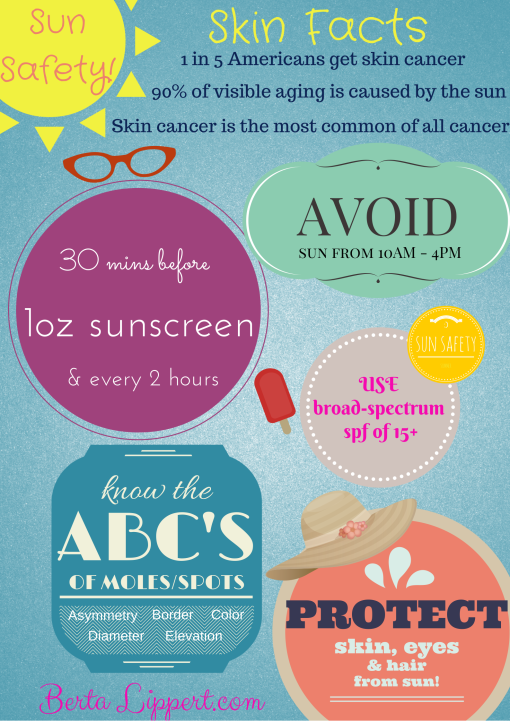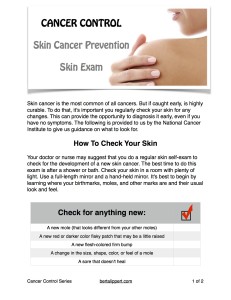Did you know skin cancer is the most common of all cancers? Nearly 50% of all cancer diagnoses in the US are skin cancer with 1 in 5 Americans developing it in their lifetime.
The three most common types of skin cancer are Melanoma, Basal cell, and Squamous cell skin cancer. Their name represents the location of origin for each type of cancer. Melanoma begins in the melanocytes. These are the cells that produce our pigment known as melanin. Basal cell skin cancer begins in the basal cell layer of the skin and squamous cell skin cancer begins in squamous cells.
Basal cell skin cancer and squamous cell skin cancer are referred to as non-melanomas to set them apart from melanoma, the more serious type of skin cancer. Although a smaller percentage of skin cancer is melanoma, it’s much more aggressive than its non-melanoma counterparts and causes the majority of skin cancer deaths.
To learn more about each type of cancer, including their symptoms, visit the National Cancer Institute’s free resource What You Need To Know About™ Melanoma and Other Skin Cancers.
The good news is if skin cancer is caught in its very early stages, it’s largely curable. This stresses the importance of screening we’ll discuss later. Our goal however, is to prevent it. So what are the risk factors of skin cancer and how can we prevent it? Let’s take a look at the risk factors first.
The following is a list of things that put you at a higher risk of developing skin cancer.
Risk Factors
Unprotected/excessive exposure to UV Radiation: This includes the sun and tanning beds/lamps.
Past severe sunburn: Just one severe sunburn in your past leaves you at a higher risk.
Family/personal history: Family members with skin cancer or a personal previous bout with skin cancer leaves you at a higher risk for developing skin cancer or additional skin cancer.
Fair skin: People with pale skin who burn easy are at a higher risk of developing skin cancer.
50+ common moles: People who have many common moles increase their risk of developing skin cancer.
Workplace exposure: People who are exposed to arsenic, radium and coal tar, among others, are at an increased risk of developing skin cancer.
You can learn more about these risk factors and others here.
Prevention
Preventing skin cancer is relatively easy. We just have to be discipline in doing what we know we should. Just what should we do to prevent skin cancer? Here’s a list!
- Avoid sun when it’s strongest which is usually between 10am – 4pm.
- Shade will be your best friend when your goal is preventing skin cancer.
- Use sunscreen and lip balm with broad spectrum protection of at least 15. 30 is better. Apply it generously 30 minutes prior to sun exposure and every two hours or after swimming or sweating.
- Wear tightly woven fabric to guard as much skin as possible.
- Wear a hat that will provide shade for your face, ears and neck.
- Protect your eyes with sunglasses that absorb UV radiation.
- Avoid tanning beds and sun lamps.
- Be sure to protect yourself even on cloudy days! 80% of UV rays pass through clouds.
Finally, I want to stress the importance of checking your skin for any unusual moles or skin changes. Do you know the ABCDE’s of skin cancer? If not, check out this free resource, The ABCDE’s of Skin Cancer from The Skin Cancer Foundation to learn more.
You will know your body best and it’s important you’re diligent in skin exams to detect any changes immediately and seek the help of a doctor.
To do this, I created an easy to follow checklist with information provided by the National Cancer Institute on what to look for. Follow these guidelines and use the sun safety information above and you’ll be well on your way to preventing skin cancer!
Skin Cancer Prevention Skin Exam Checklist
Resources: National Cancer Institute, American Cancer Society, Skin Cancer Foundation, American Academy of Dermatology




